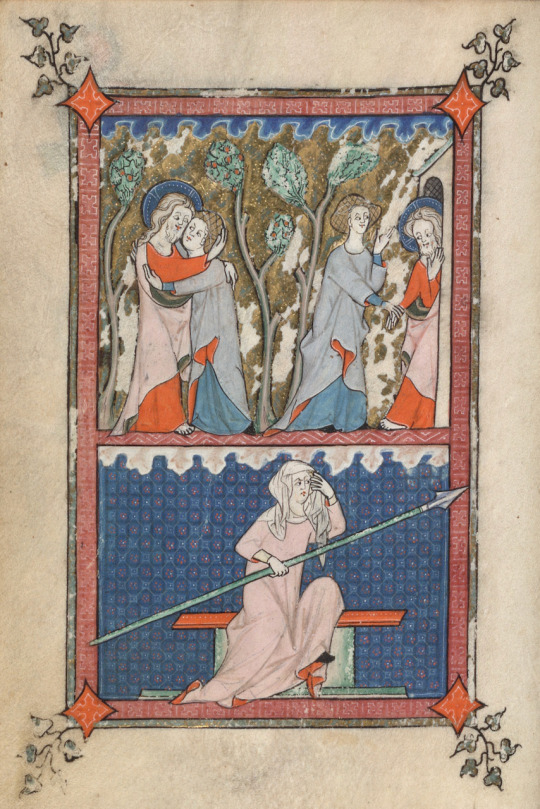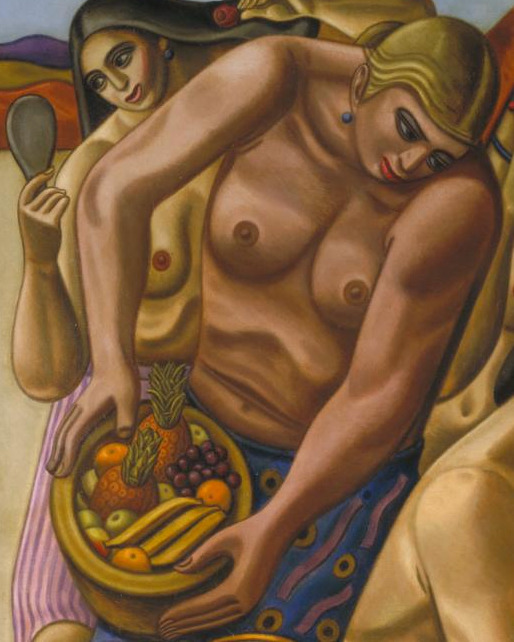Eyeballing the weird, violent and erotic art inspired by the Holy Bible • built by @rojasburke
Don't wanna be here? Send us removal request.
Text

st. michael defeating satan
from the hours of marguerite d'orléans, france, 15th c.
source: Paris, BnF, Latin 1156 B, fol. 165r
3K notes
·
View notes
Text

Berthe Brincour, 1879-1947
Salome, n/d, gouache on paper, 114x119 cm
Collection du Musée national d’archéologie, d’histoire et d’art Luxembourg (MNAHA) Inv. 1947-008/095
29 notes
·
View notes
Photo

Harrowing of Hell
A detail from a 15th Century Dutch painting of the resurrection, artist(s) unknown; attributed to the Master of the Amsterdam ‘Death of the Virgin’ via the Rijksmuseum
4 notes
·
View notes
Photo



Man of sorrows
The painting stands more than six feet tall. It’s one panel of a winged altarpiece made in 1504 for the private chapel of a wealthy family in Frankfurt. The artist’s name has been lost. The work is in the collections of the Städel Museum.
2 notes
·
View notes
Photo

Flagellation (detail)
Luca Signorelli made this tempera-on-panel painting around 1485 for the confraternity of the Raccomandati at Santa Maria del Mercato in Fabriano, a religious brotherhood whose members were known for practicing self-flagellation. Whatever the artist intended, or his patrons perceived back then, it’s hard for modern eyes to ignore the erotic gay energy. “Called by one critic ‘the master of the buttocks,’ Signorelli lavishes attention on the contours and textures of the male body—in particular, its muscles, skin, and hair,” scholar John G. Champagne observes:
What is disturbing about the flagellation scene portrayed in the Brera standard is its allure. Like all forms of sexuality, masochism is coded; Signorelli’s scene has all the marks of an S/M scenario, from the highly theatricalized poses of the torturers to the fetish-wear of the loincloths on both Christ and his torturers to the fully-dressed figures watching the scene unfold to the proscenium arch that frames the action as theater. We are presented the male bodies via a gaze loving in its attentiveness.
The full painting and its companion piece, a nursing madonna, can be viewed at the Brera Museum’s website.
7 notes
·
View notes
Photo

‘Then Pilate took Jesus and had him flogged’
Oil on panel painting by Jan Provoost, c.1510–15, now in the Saint Louis Art Museum, which comments:
“In a splendid display of architecture, coloristic effects, and lively figures, the artist achieves a delicate balance between pain and sadness on the one hand and airy landscapes peopled with elegant figures on the other.”
6 notes
·
View notes
Text

'for all flesh had corrupted its ways'
Noah builds his ark in the far background while the party continues among the wicked ones who are about to be blotted from the earth by a wrathful Old Testament god. Flemish artist Karel van Mander made the oil-on-copper painting in the late 15th Century.
(Image accessed at the Staedel Museum.)
3 notes
·
View notes
Text




So. Much. Stabbing. in the Old Testament!
The illustrations are from the Getty Museum's Weltchronik, a Bavarian manuscript made around 1400.
2 notes
·
View notes
Text



Stag party
Lucas Cranach the Elder made the woodcut in 1509, commissioned by some lord or other who was really into big game hunting, hence the abundance of ungulates sharing paradise with Eve and Adam. The images here come from the public domain scan online at The Cleveland Museum of Art.
9 notes
·
View notes
Text

'Ye shall be as gods'
What is up with that serpent in Genesis? The narrator tells us it is a wild animal like any other made by God, but "more crafty." And then it starts talking – and somehow it knows more about the Tree of Knowledge than God had revealed to Eve and Adam. "When you eat of it your eyes will be opened, and you will be like God, knowing good and evil,” the serpent says.
The depiction in this early 16th century woodcut engraving by Lucas Cranach the Elder is appropriately enigmatic: a snake-tailed woman whispering in Eve's ear. The print is in the British Museum [CC BY-NC-SA 4.0]
7 notes
·
View notes
Text

'with blood almost all things are cleansed'
Showers of blood from the wounds of a crucified Jesus rain down upon a gathering of naked, sinful followers in this 17th century print from the Rijksmuseum. It was made by an unknown artist in the Netherlands.
8 notes
·
View notes
Text

They ain't heavy
Jesus carries a demonic figure, perhaps Satan himself, along with several lifeless bodies as he climbs up to die by crucifixion. Below, John the Baptist and a personification of Christian faith lead a naked man seeking directions to the right path. The stained glass window, made by an unknown artist around 1560, is in the Rijksmuseum.
3 notes
·
View notes
Text


Really getting into Jesus
This perplexing illustration comes from the Rothschild canticles, a prayer book made in Flanders or Germany around 1300. Why is the woman aiming a spear at Christ's bloody, open wound?
Art historian Sherry Lindquist, makes this observation:
"Jeffrey Hamburger’s work has given us suggestive case studies that sensitively describe the unusually intimate extra-liturgical relationship that certain nuns and devout laywomen in Flanders and Germany forged with the body of Christ through their images. These images often included memorable nudes, such as we find in the Rothschild Canticles, where a woman, presumably the sponsa, or allegorical bride of Christ, aims her phallic spear to the other side of the bifolium where a nude Christ holding a whip points to his gaping and bloody side wound." [source: "The Meanings of Nudity in Medieval Art: An Introduction" by Sherry C.M. Lindquist ]
#body of christ#nudity#medieval art#rothschild canticles#illuminated manuscript#wound of christ#s&m#whip#bondage
13 notes
·
View notes
Text

'As I have done, so God has paid me back'
The Canaanite king Adoni-Bezek made a habit of mutilating the limbs of rulers he defeated. In Judges (1:4-7), the Israelite forces led by Judah and Simeon kill 10,000 men in their bloody assault on Canaan, capture the Canaanite king Adoni-Bezek, and go full-on eye-for-an-eye with him: “Seventy kings with their thumbs and big toes cut off used to pick up scraps under my table," Adoni-Bezek says. "As I have done, so God has paid me back.”
The image is from a lavishly illustrated edition of the Weltchronik manuscript copied and illuminated around 1400, now belonging to the Getty Museum.
2 notes
·
View notes
Text



'I am called the spirit of lust'
Many stories about Saint Anthony’s temptation and torture by Satan were recorded in a biography written in Greek around 360 AD by Athanasius of Alexandria. In one quotable passage, the tempter tells the saint: "I am called the spirit of lust. How many have I deceived who wished to live soberly, how many are the chaste whom by my incitements I have over-persuaded! I am he on account of whom also the prophet reproves those who have fallen, saying Hosea 4:12, You have been caused to err by the spirit of whoredom. For by me they have been tripped up. I am he who have so often troubled you.”
The images are details from a 1950 painting by William Roberts from the Tate Collection.
11 notes
·
View notes
Photo

Your Valentine
Saint Valentine’s skull, crowned with flowers, is kept on display in the Basilica of Santa Maria in Cosmedin, Rome.
[photo by Dnalor_01 via Wikimedia Commons (CC-BY-SA 3.0)]
27 notes
·
View notes
